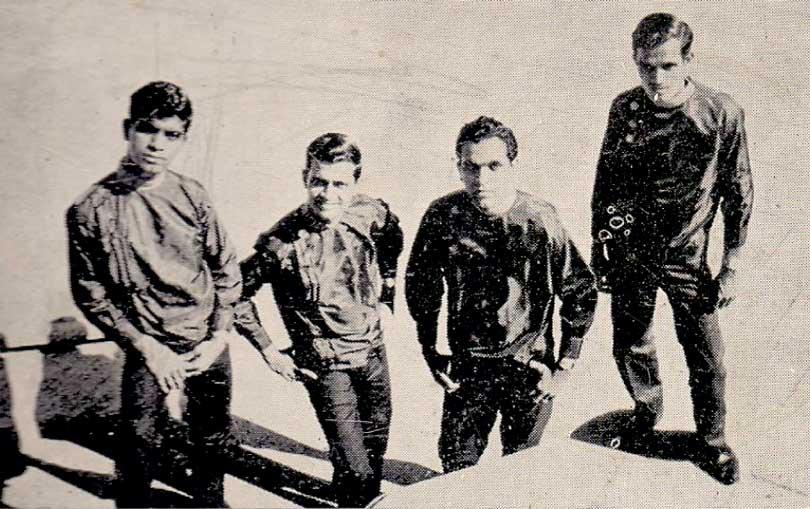Reply To:
Name - Reply Comment

 Melroy Dharmaratne’s lyrics contain a peculiar, dualistic quality. It’s hard to get around it, except by going through his songs and placing them in the period which they were written in. The most memorable and best loved of them were, I believe, written in the latter half of the 1960s, when pop culture was flourishing (with the Moonstones and the Jetliners, among other groups, churning out one hit after another) and adverse political developments were making the continuation of the old order difficult and unsustainable. These songs are, in that sense, a reminder of an era of social, economic, cultural, and political transition.
Melroy Dharmaratne’s lyrics contain a peculiar, dualistic quality. It’s hard to get around it, except by going through his songs and placing them in the period which they were written in. The most memorable and best loved of them were, I believe, written in the latter half of the 1960s, when pop culture was flourishing (with the Moonstones and the Jetliners, among other groups, churning out one hit after another) and adverse political developments were making the continuation of the old order difficult and unsustainable. These songs are, in that sense, a reminder of an era of social, economic, cultural, and political transition.
In reviewing an anthology like this it’s futile to draw arbitrary lines between popular and arty output, because the artist never embodies one to the exclusion of the other. For instance, how peechan is “Ayubowan” (H. R. Jothipala), and how arty is “Dura Atha Atheethe” (Victor Ratnayake)? Distinctions of that sort serve no purpose; they detract from the very purpose of criticism. To me then, the richness of Melroy’s lyrics comes, not from a division between the high flown and the popular, but from an intermingling of contradictory social, cultural, and political impulses. In much of his work, you can infer a conflict between the narrator and his surroundings. The milieu of the narrator eventually turns him into a transmitting ideologue for his class. There are songs in which this does not happen, where the narrator transcends his background, but for every such attempt there’s a horde of others where he fails.
Let me turn to some of Melroy’s songs. “Sakalabujan”, arguably the most popular Shiromi Fernando tune out there, tells us about its protagonist, the forever busy servant boy, from the perspective of the younger daughter of the master. The lyrics are not really crude or simple, but they tend to vacillate between ridicule and compassion: Sakalabujan wears shorts (hand-me-downs, presumably), mother tells him to fetch a pail of water and sister tells him to sweep the floors, he’s eight (underage labour was not illegal at the time) but dextrous, and he’s the resident garden katussa’s enemy. These conclude with a touching revelation: he doesn’t have a mother or father, and he’s “been living in our home” since he was small.
It should come to no surprise that in the 1960s this should have been the usual attitude to servants among the upper middle class. There’s ridicule, but there’s also sympathy, though not the sort that can empower the narrator to wish for his emancipation. This is not shocking: back then, unlike now, relations between servants and householders bordered on the feudal. An upper class woman from that era told me about how much she lamented the way servant-master relations were being “debased” by money; she complained that servants today were out only for the money, when back in her day “they became part of the family and didn’t at all hesitate to go beyond the call of duty.” Here a sense of (partly) belonging to the master’s household is seen as a privilege, a “token of appreciation” for the more committed servants. Sakalabujan, in that sense, is privileged by his baby nona sympathising with him.
This is not to suggest that “Sakalabujan” represents everything Melroy Dharmaratne’s songs stand for. In the Dharmaratne Brothers era tunes, that quality doesn’t come up as often as it did later on – instead of contemplating on social reality, these early melodies project a fairly exuberant, blissful, optimistic perspective. They are the most intensely personal ditties in Melroy’s anthology; the sense of rejection felt by the narrator in “Priyangika”, the sense of wonderment at seeing the passing beauty in “Raja Kumari”, and the solidarity of the four brothers in “Sahodara Hathara Denek” are thus more tame and straightforward.
Touch of humanity
But even here his view of the world comes out. Take “Dikkasada Nadu.” It’s not as popular as the other songs, but it retains something of their jubilant mood though there’s nothing in the story that warrants such jubilance. Melroy sings for the divorced and the separated not on the basis of the suffering divorce brings to the spouses, but of the children’s plight, and even that, as he makes it clear, is because separation within families tends to “eject drunkards, criminals, and prostitutes to society.” The tone is didactic, with a touch of humanity. But read it more carefully: by associating the divorced with the criminal, and pleading with the parents to return, the performers very nearly become middle class moralists.
On the other hand, a song like “Varsity Kollo” reveals a kind of youthful delight and naiveté which was to become horrendously out of tune with the reality not too soon afterwards. The “varsity” in the title, of course, is Peradeniya: the kollo probably are middle class, the girls they hanker after either “udarata manikela” (upcountry girls) or “kolamba nonala” (Colombo ladies); they are in it for the BA; and despite their backgrounds they will all be subjected to the same bout of ragging. It’s flippant, in a way apolitical, but measured against the time in which it was set, the lyrics seem overly idealistic: by 1968, the number of undergraduates had more than tripled over the decade, the number of arts undergraduates had increased more than sevenfold, and diminishing prospects for the tide of arts graduates had led to an even bigger tide of unemployed youth – who in 1971 would resort to violence and insurrection.
To me, the best and the most profound of the lot has to be “Sebastian Obath”. Again, like “Dikkasada Nadu” it’s not popular. It’s in some ways a conventional love conquers all ballad: the unnamed rich girl, in love with a poor boy, has to surmount untold obstacles: being caged like a bird at home, being constantly threatened by her father – he tells her he’d rather have her killed than see her with that boy – and having a thovil ceremony performed (with vas kavi recited against Sebastian). But this merely simplifies an otherwise complex song.
What makes it stand out is its quick, hurried pace, its plaintive mood, and its jubilant yet sober climax: “they did everything they could, and when they failed, they let me go.” To add to that, the narrator is Shiromi – not the Shiromi of “Sakalabujan” and “Konda Namagena”, but a more adolescent girl. We get it that “victory” was obtained at an exorbitant cost; we also get it, from the way her family treats her, that she may be Buddhist and that Sebastian may be a non-Buddhist (Catholic? Non-Sinhala? We don’t know). In his revelation of the misery and tragedy of fulfilling their hopes, the lyricist thus gives us a devastatingly searing indictment of everything: marriage customs, the oppression of young women, and taboos of class, caste, faith, and race. It’s the best of the lot because it embraces a wider milieu and reality, which is why it’s a pity it wasn’t well received by the same public that listened to Sakalabujan.
Middle class
Here I am not suggesting that Melroy’s songs, like most other pop songs from the sixties, were not as political as Nanda Malini’s Pawana would be in the eighties. But as Richard Powers put it in a review of Doctor Zhivago, critics don’t bother to say what is political and what is not. The truth is that most Sinhala pop songs from this period were middle class, if not upper middle class. This did not, and does not, make them irrelevant; quite the opposite, in fact. That’s why an anthology like Dharmaratne’s is so valuable: it takes us back.
In that respect it’s instructive to return, after perusing the songs and the lyrics, to the author’s preface. Melroy makes his views on composing and writing songs clear at the outset: “a song must,” he informs us, “first be sarala, then sundara, and then arthawath.”
He draws a line between the good and the mediocre; the distinctions he makes there will not, I feel, sit well with young readers, but one gets away with an understanding of why he makes them at all. For instance, while “Me Sinhala Apage Ratayi”, “Seethala Wathura Galayi”, and “Sinhala Jana Sangeetha Mawuna”, and lighter essays like “Pipi Pipi”, “Yakada Thalanna”, and “Loke Jeewath Wannata”, get full marks, he dismisses “Oye Ojaye” (which for him is an unsuccessful attempt at capturing the essence of Veddha society), “Gune Aiyage Kamare”, and “Uncle Johnson” (which betray a lack of erudition). It won’t be nitpicking to add that all three were written by Hemasiri Halpita and performed by Nihal Nelson and the Gypsies, or that they all represented a transition from the pop culture Melroy embodied to a more lumpen middlebrow culture in the eighties. It’s rather like Weber criticising Beethoven, Beethoven putting down Rossini, Sinatra reproving Elvis, and Elvis badmouthing the Beatles, though I suspect and admit that these may not be the correct analogies to draw.